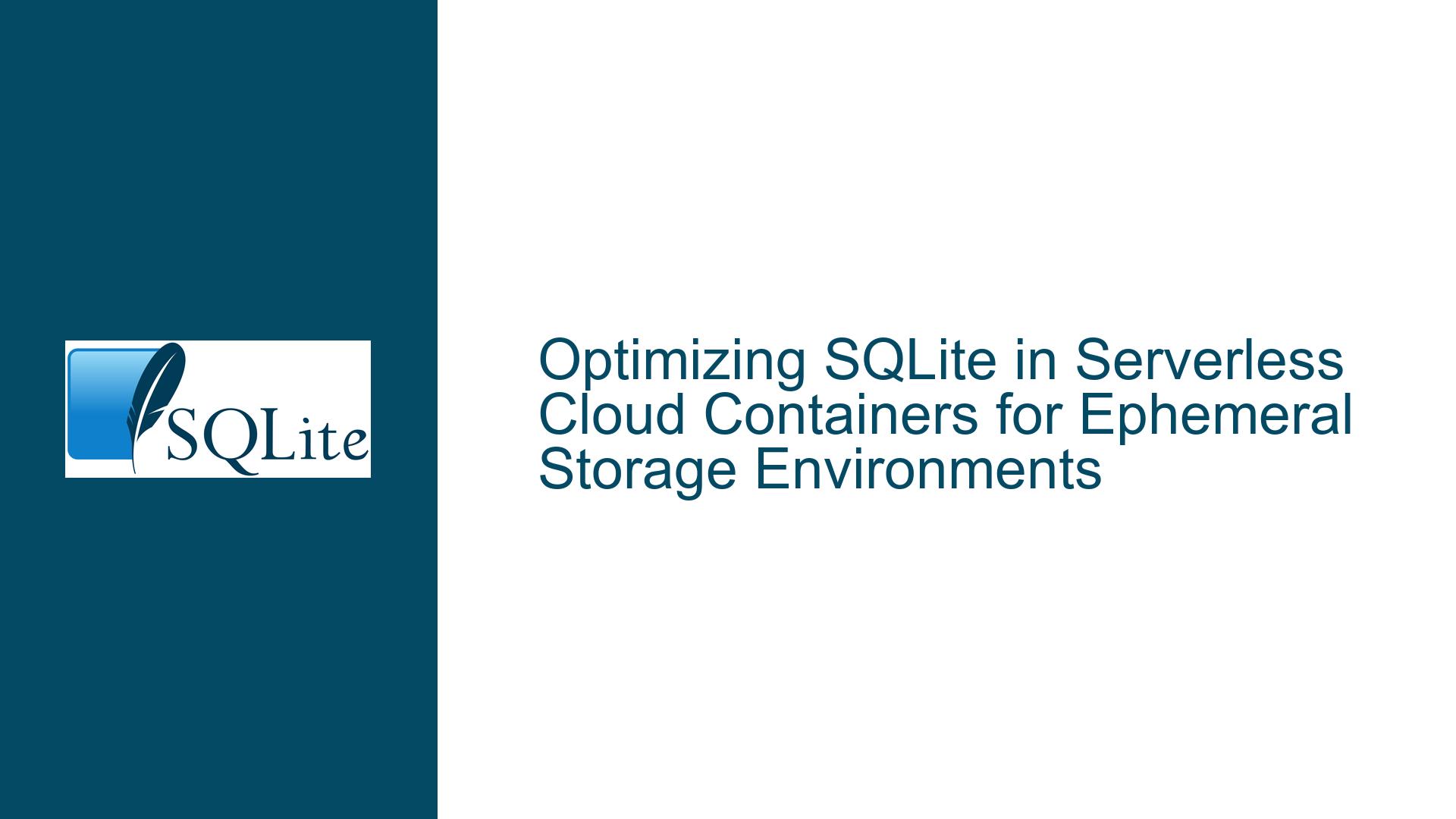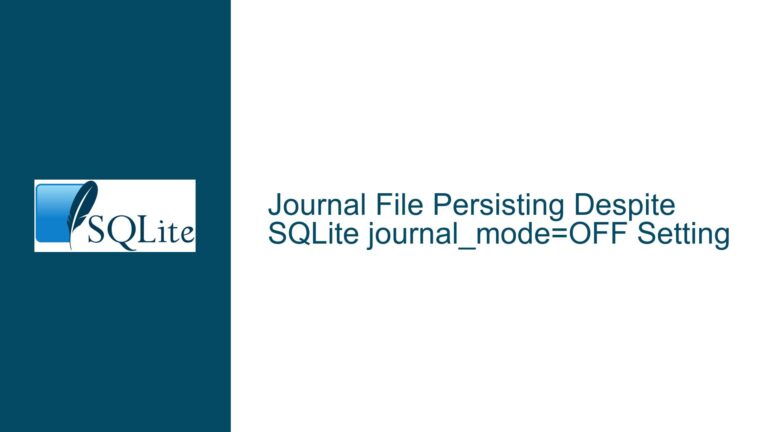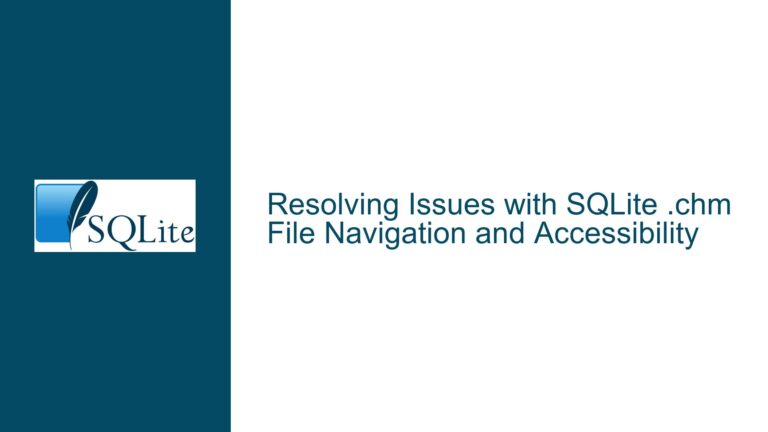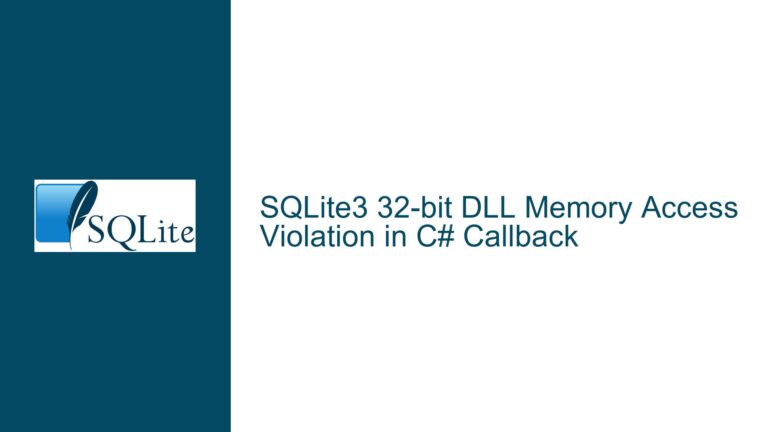Optimizing SQLite in Serverless Cloud Containers for Ephemeral Storage Environments
Understanding SQLite in Serverless Cloud Containers with Ephemeral Storage
SQLite is a lightweight, serverless database engine that is widely used due to its simplicity, portability, and efficiency. However, when deploying SQLite in a serverless cloud container environment, such as AWS Lambda, Azure Functions, or Google Cloud Run, several challenges arise due to the ephemeral nature of the storage. In these environments, the container’s filesystem is temporary, meaning that any data written to the disk will be lost once the container terminates. This poses a significant problem for SQLite, as the database file must persist across container invocations to maintain data integrity.
The core issue revolves around how to make the SQLite database file available to the application upon container startup and how to ensure that any changes made to the database during the container’s lifecycle are saved back to persistent storage before the container terminates. This requires a robust strategy for managing the database file’s lifecycle, including initial provisioning, periodic backups, and final synchronization.
Potential Challenges with SQLite in Ephemeral Cloud Environments
One of the primary challenges is ensuring that the SQLite database file is available to the application when the container starts. In a traditional VM-based environment, the database file can be mapped from the host VM into the container, allowing the application to access it directly. However, in a serverless environment, the container’s filesystem is ephemeral, meaning that the database file must be fetched from a persistent storage service, such as AWS S3, Azure Blob Storage, or a network file system like AWS EFS or Azure Files.
Another challenge is ensuring that any changes made to the database during the container’s lifecycle are saved back to persistent storage before the container terminates. This requires a mechanism for periodically syncing the database file to persistent storage or performing a final sync just before the container shuts down. This can be particularly challenging in serverless environments where the container’s lifecycle is managed by the cloud provider, and the application may not have direct control over when the container is terminated.
Additionally, there are performance considerations when using SQLite in a serverless environment. SQLite is designed to be a single-file database, which means that all database operations are performed on a single file. In a cloud environment, where the database file may be stored on a network file system or fetched from object storage, the latency and throughput of the storage service can significantly impact the performance of the database. This is especially true for write-heavy workloads, where the database file must be frequently synced to persistent storage.
Strategies for Managing SQLite in Serverless Cloud Containers
To address these challenges, several strategies can be employed to effectively manage SQLite in serverless cloud containers. The first step is to ensure that the SQLite database file is available to the application when the container starts. This can be achieved by baking the database file into the container image, which is useful for initial use cases or for read-only workloads. However, for write-heavy workloads, this approach is not sufficient, as the database file will need to be updated during the container’s lifecycle.
A more robust approach is to fetch the database file from a persistent storage service, such as AWS S3 or Azure Blob Storage, when the container starts. This can be done using a custom initialization script that runs when the container is launched. The script can download the database file from the storage service and place it in the container’s filesystem, where it can be accessed by the application. This approach ensures that the application always has access to the latest version of the database file, even if the container is terminated and restarted.
Once the database file is available in the container, the next challenge is to ensure that any changes made to the database are saved back to persistent storage before the container terminates. This can be achieved by implementing a periodic sync mechanism that uploads the database file to the storage service at regular intervals. For example, the application could be configured to sync the database file every 5 minutes or after a certain number of write operations. This approach reduces the risk of data loss in the event of an unexpected container termination.
Alternatively, the application could implement a final sync mechanism that uploads the database file to the storage service just before the container shuts down. This can be done by trapping the container’s shutdown signal and executing a sync operation in response. However, this approach relies on the container receiving a shutdown signal, which may not always be the case in a serverless environment. For example, if the container is terminated due to a resource constraint or a system failure, the shutdown signal may not be sent, and the final sync operation may not be executed.
To mitigate this risk, it is recommended to use a combination of periodic and final sync mechanisms. The periodic sync ensures that the database file is regularly backed up to persistent storage, while the final sync provides an additional layer of protection in the event of a graceful shutdown. Additionally, the application should be designed to handle the case where the database file is not available at startup, such as by creating a new database file if one does not exist.
Another consideration is the use of a sidecar component to manage the database file’s lifecycle. A sidecar is a separate process that runs alongside the main application in the same container instance. The sidecar can be responsible for fetching the database file from persistent storage when the container starts, periodically syncing the database file to persistent storage during the container’s lifecycle, and performing a final sync before the container terminates. This approach decouples the database file management logic from the main application, making it easier to maintain and update.
In terms of performance optimization, it is important to consider the latency and throughput of the storage service when using SQLite in a serverless environment. For example, if the database file is stored on a network file system like AWS EFS or Azure Files, the performance of the database may be impacted by the latency of the network. To mitigate this, it is recommended to use a local cache for the database file, where the database file is stored in the container’s local filesystem during the container’s lifecycle. The local cache can be periodically synced to the network file system to ensure data persistence.
Additionally, it is important to consider the size of the database file when using SQLite in a serverless environment. SQLite is designed to handle databases up to several terabytes in size, but in a serverless environment, the size of the database file may be limited by the available storage in the container’s filesystem. To address this, it is recommended to use a database sharding strategy, where the database is split into multiple smaller files that can be managed independently. This approach allows the application to scale horizontally by distributing the database across multiple containers.
Finally, it is important to consider the security implications of using SQLite in a serverless environment. The database file may contain sensitive information, such as user credentials or personal data, which must be protected from unauthorized access. To ensure the security of the database file, it is recommended to use encryption at rest and in transit. For example, the database file can be encrypted using SQLite’s built-in encryption extension, and the file can be transferred to and from the storage service using secure protocols like HTTPS or SFTP.
Conclusion
Deploying SQLite in a serverless cloud container environment presents several challenges, particularly due to the ephemeral nature of the container’s filesystem. However, by implementing a robust strategy for managing the database file’s lifecycle, including initial provisioning, periodic backups, and final synchronization, it is possible to effectively use SQLite in a serverless environment. Additionally, by optimizing performance, managing database size, and ensuring security, SQLite can be a viable alternative to traditional DBaaS solutions like Postgres or MySQL in serverless architectures.






